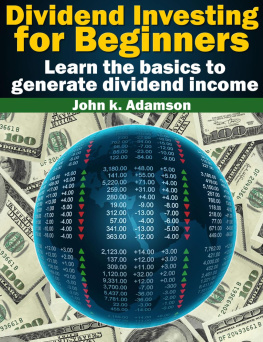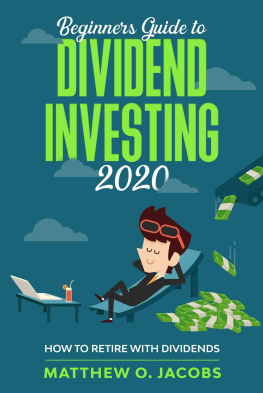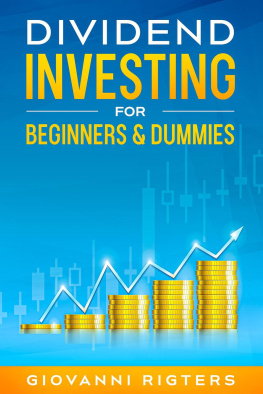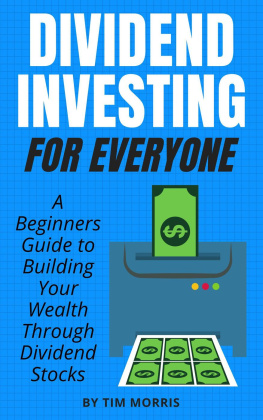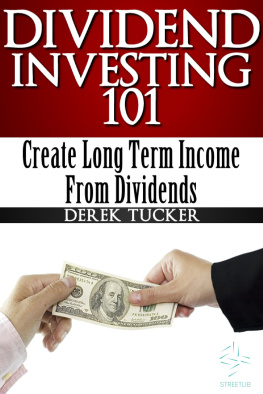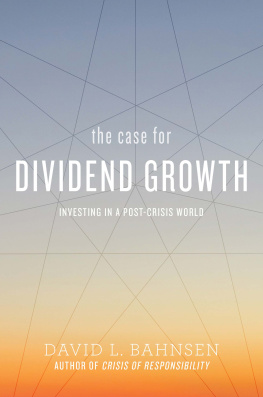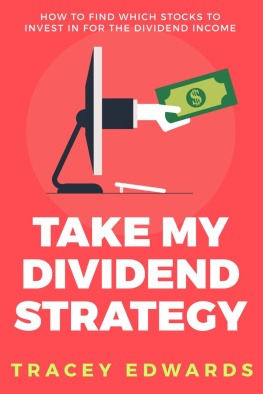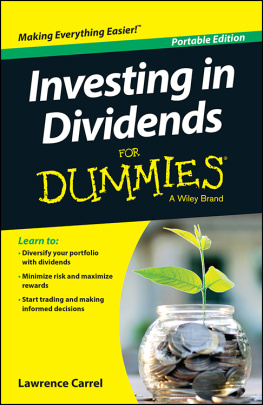Dividend Investing for Beginners Learn the Basics to Generate Dividend Income from stock market
Stock Market for Beginners, Volume 1
by John K. Adamson
Published by ANIAMK Publishing, 2013.
While every precaution has been taken in the preparation of this book, the publisher assumes no responsibility for errors or omissions, or for damages resulting from the use of the information contained herein.
DIVIDEND INVESTING FOR BEGINNERS LEARN THE BASICS TO GENERATE DIVIDEND INCOME FROM STOCK MARKET
First edition. October 8, 2013.
Copyright 2013 John K. Adamson.
Written by John K. Adamson.
10 9 8 7 6 5 4 3 2 1
To my daughters,
Monica and Alicia
for their wealthy and healthy future.
Introduction
W hen non-investors think of the stock market, they imagine a world of wheeling and dealing, with enormous fortunes won and lost in the blink of an eye. In my first year of trading, I tried to follow this model. The only difference was that my fortunes weren't enormous. That was definitely a good thing because it limited my losses from all the rookie mistakes I made.
Everything changed for me when I discovered dividend investing.
I had become disillusioned with trying to pick growth stocks even before the financial crisis of 2008-2009. As a beginning investor, I believed I could build my own portfolio of winning stocks if I did enough research, but after months spent glued to the computer, the best I could come up with was a random mix of winners and losers. The results of my obsessive research were a wash in terms of growth.
Chastened, I decided to become more conservative and follow the conventional wisdom of buy and hold. I bought shares in an index fund and resolved to hang in there no matter what the market did. And in the years of accelerating growth between 2005 and 2008, I did very well indeed.
If you follow the news, then you know what happened next. Between October 2008 and March 2009, the market took a nosedive and stocks lost massive amounts of value across the board. Investors who thought diversifying their investments would protect them were stunned to learn that their portfolios had lost one-third to one-half of their value.
I was in better shape during the financial crisis than many investors. I had the security of a pension from my years as an engineer in the automotive industry, and my wife, Nedra, and I had a healthy amount of savings that she insisted we keep in a money market savings account where it was insulated from the market. Still, I had substantial amounts of money invested in stocks, and my blood pressure in those two years went up as the market went down.
I was supposed to be following a buy and hold strategy, so I held on for dear life while I wondered how low the market could go. My persistence paid off as the plunge gradually reversed itself and my stocks regained nearly all of their previous value.
Nonetheless, I had learned an important lesson.
In my first year of investing, I bought shares in a few companies that paid dividends. It was more or less an accident. At the time, their stocks were showing modest growth, so to me, the dividends were just icing on the cake or so I thought at the time.
When I got my first year-end statement from my broker, I was amazed to find that my dividends from these companies had equaled or surpassed my profit from the growth of their stocks. Even though I was still frantically flipping shares in pursuit of a winner, I somehow mustered enough sense to hang on to my dividend stocks. I think it was the only rookie mistake I didn't make.
I still have those stocks today, along with many other dividend stocks. The shares themselves lost value right along with the rest of my portfolio in the bear market. They might even lose value again, but I'll continue to own them as long as they keep paying out dividends.
This book is written for the beginning investor who wants to add dividend stocks to his or her portfolio. It explains the theory and practice of basic dividend investing and walks you through the steps of buying stocks that pay dividends. A chapter on DRIPs is included to help you maximize your returns.
Dividend stocks might not be for everyone, but for me personally, I enjoy getting that quarterly payout while freeing myself from some of the ups and downs of growth investing.
By now you have probably figured out that I'm a cheerleader for dividend investing. I hope to demonstrate to you in practical terms why my enthusiasm makes sense. My job in this book is to show you how I find dividend stocks, and to give you some tips that have worked for me to maximize my income from them.
To your prosperity and enjoyment,
- John K. Adamson
Chapter One
The Case for Dividend Investing
I learned about dividend investing while I was still in a growth investing mindset, and I believe that most beginning investors are in the same position. So I'm going to start by explaining the differences between the two.
Growth Investing vs. Dividend Investing
I nvesting for growth means buying stocks in the hope that their share price will go up after you buy them. The old saying, "buy low and sell high," is an apt description. Investing for growth means you don't make any profit from your stocks until you actually sell them and only if you can sell them at a higher price per share than you paid for them.
Dividend investing is sometimes called "investing for income" because dividend stocks pay you income on a regular basis (usually quarterly), regardless of their share price. Not all stocks pay out dividends, but at first glance, dividend stocks look just like any other stock. They're publicly traded on the major indexes, and you buy your shares through your brokerage account. Sometimes their price per share goes up, and sometimes it goes down. As a dividend investor, you will want to "buy low," just as a growth investor would, but once you own the stock, any growth in share price is added to the fact that it's likely to pay dividends for as long as you own the stock.
Dividend Investing vs. Buy and Hold
A t first glance, dividend investing looks a bit like the conservative "buy and hold" strategy so beloved of financial gurus, but there are important differences. The growth investor buys and holds with the aim of selling his shares for more than he paid for them at some point in the future and profiting from that sale. That approach is based on the assumption that the stock market will always recover after a downturn, and that, over a period of many years, stock prices will always increase in value at a rate that outpaces inflation.
Historically this may be true, but the volatility of the stock market in the twenty-first century has made many people skeptical myself included. Since the year 2000, there have been two major downturns in the market one in 2002, and one in 2008. I guess it's not politically correct to call them "crashes," but trust me, watching helplessly as your portfolio loses one-third to one-half of its value feels a lot like being in an automobile accident in slow motion.
It's true that both times the market recovered and went on reach historic highs. But the bear markets of the twenty-first century left a bad taste in many investors' mouths. We no longer take it as an article of faith that the market will always recover after a downturn, and we are approaching growth investing with a newfound caution.
I invest heavily in dividend stocks for four reasons:
- When stock prices are high, dividends add to my income
- When stock prices are low, dividends help me maintain my income
- Whether stock prices are high or low, dividends help me lower my risk
- Until 2012, the tax rate on dividends was 0% in my tax bracket, with a 15% maximum. As of early 2013, the maximum tax rate on dividends has gone up, but their tax rate in my income bracket continues to be 0%. These figures will hold until U.S. tax policy is renegotiated by Congress.

